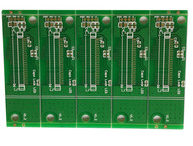The amount of SMT red glue varies according to the size of PCB components. The manual dispensing SMT red glue machine controls the amount of glue according to the dispensing time, and the automatic dispensing SMT red glue machine controls the spot SMT red glue machine through different glue nozzles and time; the other is brushing glue. SMT red glue is printed by SMT patch stencil. There are standard specifications for the opening size of the SMT steel mesh. Today we will take a closer look at the common problems and solutions of SMT red glue patches!
SMT red glue patch
SMT patch red glue common problems
1. Insufficient thrust
The reasons for insufficient thrust are: 1. The amount of glue is insufficient. 2. The colloid is not 100% cured. 3. The PCB board or components are contaminated. 4. The colloid itself is fragile and has no strength.
2. Insufficient amount of glue or leakage
Reasons and countermeasures: 1. The PCB screen for printing is not cleaned regularly. It should be cleaned with ethanol every 8 hours. 2. There are impurities in the colloid. 3. Unreasonable opening of the screen, too small or too small dispensing pressure, and the designed amount of glue is insufficient. 4. There are bubbles in the colloid. 5. If the dispensing head is clogged, clean the dispensing nozzle immediately. 6. If the preheating temperature of the dispensing head is not enough, the temperature of the dispensing head should be set to 38°C.
3. Drawing

Wire drawing refers to the phenomenon that the patch glue cannot be disconnected during glue dispensing, and the patch glue is connected in a wire-like manner in the direction of movement of the dispensing head. There are many wires, and the patch glue covers the printed pads, which will lead to poor soldering. Especially when the size is large, this phenomenon is more likely to occur when using a dispensing nozzle. The wire drawing of the patch adhesive is mainly affected by the wire drawing of its main component resin and the setting of the dot coating conditions.
Solution:
1. Reduce the movement speed
2. The lower the viscosity and the higher the thixotropy of the material, the smaller the tendency of wire drawing, so try to choose this kind of patch adhesive
3. Adjust the temperature of the thermostat slightly higher, and forcibly adjust it to a low-viscosity, high-thixotropic patch adhesive. At this time, the storage period of the patch adhesive and the pressure of the dispensing head must also be considered.
The difference between SMT and traditional through-hole technology in PCB design
The fully automated process can improve the accuracy of component placement, reduce manual labor, provide consistent quality and reduce costs. We usually accumulate a lot of knowledge about SMT,
SMT
What are the advantages of through-hole to SMT conversion?
Surface mount PCB components (commonly referred to as SMD-surface mount devices) are smaller and lighter than through-hole components. This allows for lightweight boards and higher density components.
SMT does not require pre-drilled plates, which reduces manufacturing time and costs. The process is also fully automated, which can quickly produce high-precision and repeatable circuit boards, thereby further reducing costs.
Since the component leads cannot pass through the circuit board, the components can be mounted on both sides of the circuit board. This opens up more design possibilities, and more functions can be packaged into the same circuit board area.
PCB manufacturers stopped using many through-hole components, and most advanced components are not compatible with through-hole mounting. SMDs are also generally cheaper than similar products with through holes.
Automatic assembly improves installation reliability and reduces errors. It also allows more thorough and accurate testing of circuit boards.
SMT
What is involved in the through-hole conversion of SMT?
When evaluating products for conversion, we will identify all potential issues that may affect the circuit board, such as:
1. The end use of the product (especially temperature and temperature cycle)
2. Mechanical constraints (form factor, vibration, etc.)
3. Component voltage, current and rated power
4. Component availability
5. Programming and testability issues